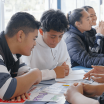Prepare the physical and virtual environments for flexibility and personalisation
Suggestion for implementing the strategy ‘Planning using UDL in primary settings’
On this page:
On this page:
Current page section: Prepare environments for flexibility
Go to top of current page: Prepare environments for flexibility
Go to top of current page: Prepare environments for flexibility
Go to top of current page: Prepare environments for flexibility
Student-led design for diversity
Student-led design for diversity
Consider how you support student agency in the inclusive design of your learning space.
No captions or transcript
Knowledge of learners influences design decisions
Knowledge of learners influences design decisions
Anita Patel describes how UDL thinking has influenced her practice.
Provide comfortable furnishing
Provide comfortable furnishing
Physical environments don’t need to be new to be flexible.
Give students the opportunity to select the options available in their learning space.
![10841 [DSC-0212.JPG]](https://inclusive-live-storagestack-assetstorages3bucket-3uty0hejzw6u.s3.ap-southeast-2.amazonaws.com/public/inclusive-education/example-images/DSC-0212__ScaleMaxWidthWzEwODZd.JPG)
Source: Ministry of Education | Te Tāhuhu o te Mātauranga
Inclusive design online
Inclusive design online
Engagement: reducing anxiety to promote engagement.
Example: Regularly touch base with students through Google comments or messaging.
Representation: using multiple examples to activate prior knowledge.
Example: Students post examples of what they know already in a Padlet using text, image, video, audio, and web page links.
Action and Expression: supporting understanding of content.
Example: Use narrated video to clarify steps involved in an activity or learning task.
Reflection questions
Reflection questions
Reflect on the following questions for your context.
- How can we more effectively involve all students in the design of our flexible learning space?
- How can we improve the design of online environments to remove barriers to access and engagement?
- Can our learning space be changed and rearranged based on user needs and preferences at that time?
- How can the layout of the environment minimise threats and distractions to learning?
- How can the layout of the environment create opportunities for connection and collaboration?
- What regular processes do we have to seek student and whānau feedback on the usefulness of our physical and online environments?
Useful resources
Useful resources

UDL Virtual tour
An interactive 360 deg tour of a high school classroom to see every day examples of UDL. To navigate through the classroom, click and drag the mouse to the left or right. Click on hotspots and magnifying glasses to zoom in on specific examples. Use the map to locate and see a brief description of each UDL support.
Publisher: Maryland Learning Links

5 ways to improve student voice and choice
Five practical suggestions to support student engagement in the classroom through student voice and choice.
Next steps
More suggestions for implementing the strategy “Design considerations in primary settings”:
-
Current page Prepare environments for flexibility
-
Design assessments to enable students to demonstrate their understanding
Return to the guide “Universal Design for Learning”

How to use this site
Guide to Index of the guide: Universal Design for Learning
Understand:
- Why UDL is valuable
-
Find out about UDLShow suggestions for Find out about UDL
Strategies for action:
-
Design multiple means of EngagementShow suggestions for Design multiple means of Engagement
-
Design multiple means of RepresentationShow suggestions for Design multiple means of Representation
-
Design multiple means of Action and ExpressionShow suggestions for Design multiple means of Action and Expression
-
How to plan using UDLShow suggestions for How to plan using UDL
-
Design considerations in primary settingsShow suggestions for Design considerations in primary settings
-
Design considerations in secondary settingsShow suggestions for Design considerations in secondary settings
-
Design considerations in NCEA assessmentsShow suggestions for Design considerations in NCEA assessments
